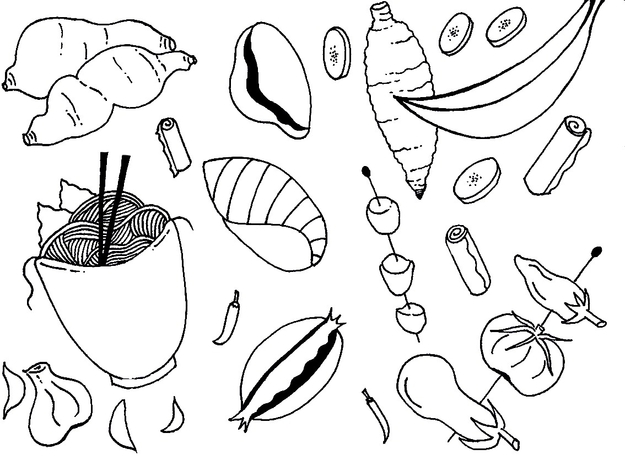The ‘foreign’ label is a politically loaded one. It automatically ‘others’ the person, object or concept that carries it. Interestingly, when talking politically, the ‘foriegn’ is often rejected. However when it comes to food, ‘foriegn’ food - often viewed as ‘exotic’ - can become a selling-point that attracts customers. The political nuances that come through in this type of marketing is important for shaping societal perceptions of the ‘other’.
Towards a diverse Europe?: A brief history of colonial migration
Diversity in food cultures found in Europe goes back to a history of colonial migration. Colonialism triggered a large movement of people. Not only did large numbers of Europeans migrate overseas, but millions of people from colonies in Asia, Africa and the Americas moved to Europe. The period before the abolishment of slavery at the end of the 18th century was characterized by the movement of African slaves to Europe. Following the end of slavery, the 19th century saw mainly Europeans moving continents in larger numbers rather than the other way around. This trend changed with two World Wars and a wave of decolonisation, there were high numbers of migration to Europe in the 20th century. Non-Europeans moved to Europe as soldiers during the wars, labour migration to fill up labour shortages to rebuild Europe or sought political asylum in Europe in the post-colonial era when colonies were gaining independence. This created minority communities to settle in various European countries, particularly in Western Europe which had faced the largest need for manual labour to rebuild their cities.
Together with the movement of peoples comes the movement of cultures, practices and traditions. Thus, “migration is fundamental to understanding the way food is used for exploring new cultures and rethinking our own.”
Liberal Paradox: What does diversity mean in liberal democracies?
Much critical literature on liberal democracies have made note of a large paradox within the liberal model. These inconsistencies emerge from the fact that economic, political and social dynamics are not in aligned. Openness in one of these spheres leads to conservatism in another. The contradiction of liberalism lies in the liberal paradox - the economic need on the one hand and the socio-political rejection on the other.
In other words, “liberal states are unavoidably characterised by degrees of openness towards some kinds of immigration and degrees of closure towards others” (Hampshire, 13). Debates surrounding immigration and migrant populations have been dominated by this framework; on the one hand are those arguing for the economic need for immigration and on the other are those that view migrants as a threat to the political entity in which they live. Taking the Netherlands as an example, this point can then be illustrated. As a country facing high labour shortages, the Netherlands relies on labour migrants to fill up certain positions of employment to uphold the economy. Nevertheless, integration of migrant populations, access to social services remain contentious topics.
Echoing the above-mentioned inconsistency between economic needs and political discourse, the way ‘foreign’ food is viewed is similar. Often cuisines brought by migrant populations are accepted and enjoyed as a marketable product with high demand. But what does the acceptance of ‘foreign’ food mean when politically, ‘foreign’ is rejected? Do we accept a community’s food while rejecting other aspects of that culture? How can the two be reconciled?
Parallel to this, it is also easy for food to become commodified and altered from its traditional flavours when being marketed as ‘foreign’. To bring light to this, various artworks also focused on critiquing the way cultures have been objectified with one dish being used to represent that entire cuisine, while more traditional recipes made with less familiar ingredients remain unknown. One exhibition centered on the objectification of Chinese culture in American society through a performance peace incorporating fashion and food. You can read more about this exhibition here.
This discussion is an attempt to ponder further on how daily activities around food and what we eat, can be contemplated within political contexts.
Sources
Emmer, Pieter C.; Lucassen, Leo: Migration from the Colonies to Western Europe since 1800, in: European History Online (EGO), published by the Leibniz Institute of European History (IEG), Mainz 2012-11-13. URL: http://www.ieg-ego.eu/emmerp-lucassenl-2012-en [2020-10-07].
Hampshire, J., 2013. The politics of immigration: Contradictions of the liberal state. Polity.
Terragni, L. and Roos, G., 2018. People Moving with Food from and to Northern Europe: Food, Migration and Multiculturalism. Editorial. Anthropology of food, (S12). https://journals.openedition.org/aof/9123
Miller, M., 2019. 'In "Eating the Other," Fashion and Food for Confronting the Objectification of Chinese Culture'. Mold. Available at: https://thisismold.com/visual/art/in-eating-the-other-fashion-and-food-for-confronting-the-objectification-of-chinese-culture#.X13xVWczYWo [Last accessed: 10/10/20]
